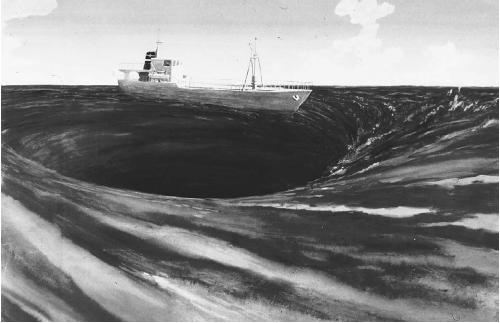
The legend of the Bermuda Triangle is said to have begun when five Navy planes took off from their base in Florida December 5, 1945 on a routine training mission known as Flight 19 – neither the planes nor the crew were ever seen again.
Long before the legend of the Bermuda Triangle became popular, Bermuda had already earned a reputation as an enchanted island. It was nicknamed “The Devil's Islands” by early sea travelers, frightened by the calls of cahow birds and the squeals of wild pigs that could be heard on shore. But perhaps the most damning tales were told by sailors terrified of shipwreck on Bermuda's treacherous stretch of reefs.
The imaginary area referred to as the Bermuda Triangle covers about 500,000 square miles of ocean off the southeastern tip of Florida; an area roughly bounded by Miami, Bermuda, and Puerto Rico. This region didn't get its name until August 1964 when Vincent Gaddis coined the term Bermuda Triangle in a cover story for Argosy magazine about the disappearance of Flight 19.
Unusual features of the area had been noted since Christopher Columbus sailed through the area on his first voyage to the New World, in which he reported a great flame of fire (probably a meteor) crashed into the sea one night and that a strange light appeared in the distance a few weeks later. He also wrote about inconsistent compass readings, which later believed as natural phenomena happens in places where True North (geodetics’ north pointing to the North Pole’s geographic location) and Magnetic North (well-known as Compass North) lined up – the two north are in fact have different scientific implications.
In the past 500 years at least 50 ships and 20 aircraft have reportedly vanished in the Triangle, most without a trace – no wreckage, no bodies, nothing. There have also been so many theories trying to explain the legend, including one suggesting that the lost city of Atlantis may lie at the bottom of the sea and be using its reputed crystal energies to sink ships and planes.
But, despite all the reports by authors around the globe regarding the untraceable missing planes and ships, is there really any mystery to explain?
Not all apparently believe there are mysteries to explain. Lieutenant A. L. Russell, in the U.S. Coast Guard's official response to Bermuda Triangle inquiries, writes “It has been our experience that the combined forces of nature and the unpredictability of mankind outdo science-fiction stories many times each year.” In the Navy's final report, the disappearance of Flight 19 was blamed on pilot error, but after several reviews the verdict was changed to causes or reasons unknown.
“The region is highly traveled and has been a busy crossroads since the early days of European exploration,” said John Reilly, a historian with the U.S. Naval Historical Foundation. “To say quite a few ships and airplanes have gone down there is like saying there are an awful lot of car accidents on the New Jersey Turnpike—surprise, surprise.”
Maritime insurance leader Lloyd’s of London does not recognize the Bermuda Triangle as an especially hazardous place and neither does the U.S. Coast Guard who says “In a review of many aircraft and vessel losses in the area over the years, there has been nothing discovered that would indicate that casualties were the result of anything other than physical causes. No extraordinary factors have ever been identified.”
In his book “The Bermuda Triangle Mystery — Solved”, American author and pilot Larry Kusche says few writers on the topic bothered to do any real investigation — they mostly collected and repeated other, earlier writers who did the same. Criticizing Charles Berlitz’s “Bermuda Triangle: The Bestselling Saga of Unexplained Mystery”, he says the book does not carry over into credible research or scholarship, and that Berlitz's research was so sloppy. “If Berlitz were to report that a boat were red, the chance of it being some other color is almost a certainty.”
Kusche claimed to have examined more than 400 pages of the Navy Board’s official investigation report regarding the disappearance of Navy planes in 1945, and found that the Board wasn't baffled at all by the incident and did not mention alleged radio transmissions cited by Berlitz in his book
About the lined up of True North and Compass North, the US Navy says that’s been an inaccurate claimed. According to him the Bermuda Triangle is not a place on earth at which a magnetic compass points towards true north. Normally a compass will point toward magnetic north. He explains the difference between the two is known as compass variation. The amount of variation changes by as much as 60 degrees at various locations around the World. If this compass variation or error is not compensated for, navigators can find themselves far off course and in deep trouble.
“Although in the past this compass variation did affect the Bermuda Triangle, due to fluctuations in the Earth's magnetic field this has apparently not been the case since the nineteenth century,” he concludes.
Fact or fiction, the Bermuda Triangle has already been accepted as a part of widespread lore that won't disappear anytime soon. There are still many travelers saying the Triangle isn't the only thing that makes The Islands of Bermuda seem magical.




Post a Comment